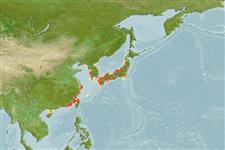Polyplacophora |
Chitonida |
Ischnochitonidae
Environment: milieu / climate zone / depth range / distribution range
Ecology
Benthic. Subtropical
Northwest Pacific: Japan, China, Taiwan, Hong Kong, and Korea.
Length at first maturity / Size / Weight / Age
Maturity: Lm ? range ? - ? cm Max length : 3.8 cm TL male/unsexed; (Ref. 283)
Body oval to elongate; oval in shape; moderately elevated. Valves yellowish brown or greenish in color blotched with dark brown or dark green. Lateral areas distinctly raised and sculptured with low radial ribs, some bifurcating towards the outer margin. Each rib ornamented with medium to large, roundish pustules. Central areas with fine, longitudinally, granosely ridged with twenty to twenty-five ridges per side. Girdle with alternating bands of light yellowish and dark greenish brown color; covered with rather large, slightly bent scales.
Found from intertidal to 10 m (Refs. 289, 75835). Motile burrower. Feeds using its radula (Ref. 125928).
Life cycle and mating behavior
Maturity | Reproduction | Spawning | Eggs | Fecundity | Larvae
Members of the class Polyplacophora are mostly gonochoric. Life cycle: Eggs hatch into lecitotrophic planktonic trocophore larvae (no veliger stage) which later metamorphose and settle on the bottom as young adults.
Burghardt, G. and L. Burghardt. 2006. (Ref. 283)
IUCN Red List Status (Ref. 130435)
CITES status (Ref. 108899)
Not Evaluated
Not Evaluated
Threat to humans
Harmless
Human uses
| FishSource |
Tools
Internet sources
Estimates based on models
Preferred temperature
(Ref.
115969): 14.9 - 23, mean 20 (based on 152 cells).
Vulnerability
Low vulnerability (10 of 100).
Price category
Unknown.
